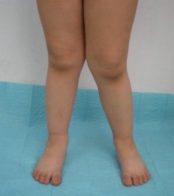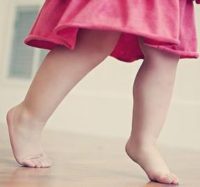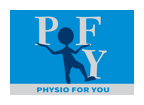Child’s Feet and Legs
THE SHAPE OF CHILDREN’S FEET AND LEGS CHANGES DURING INFANCY AND CHILDHOOD. MOST VARIATIONS THAT CAUSE CONCERN, SUCH AS IN-TURNED, OUT-TURNED, OR FLAT FEET ARE NORMAL AND WILL CORRECT SPONTANEOUSLY OVER TIME. PARENTS SHOULD ALWAYS CONSULT A DOCTOR IF CONCERNED AND A PHYSIOTHERAPIST WILL BE ABLE TO PROVIDE EXPERT ADVICE AND MANAGEMENT.
COMMON FOOT AND LEG POSTURES
FLAT FEET
These are normal in babies and young children because the arch of the foot is not yet fully developed. Most children develop an arch by five or six years of age. Flat feet tend to run in families. If an arch can be seen when the child stands on tip-toes there is no cause for concern. If your child’s flat feet are stiff and/or painful, if your child’s ankles roll in a lot, or if your child has flat feet and knee soreness, then see your physiotherapist for assessment and advice.


BOW LEGS
Bow legs are often seen until the toddler is about two or three years old. Bow legs can also run in families. Treatment is not needed unless the bowing is severe or one-sided. See your physiotherapist if you are concerned.
KNOCK KNEES
Knock knees are normal in children between three and six years of age, and usually disappear by the age of seven. Knock knees may also be seen in children who have flat feet or who are overweight. See your physiotherapist if you have concerns.


TIP-TOE WALKING
A small percentage of children walk on their tip-toes. If your child can stand with feet flat, then tip-toe walking habit usually disappears on its own. However, if your child has stiff ankles or feet (making it difficult for you to move the feet up and down or to put shoes on), or your child rarely stands with the feet flat, or the toe-walking habit persists, then seek the advice of a physiotherapist.
NIGHT-TIME LEG ACHES ’GROWING PAINS’
Young children can go through periods of waking in the night complaining of pain in their knees, thighs, calf muscles or shins. If your child has leg pain, then first seek medical advice. There is often no identifiable cause for the leg aches and it usually subsides in time. Sometimes the aches may be associated with leg muscles tightness and muscle strength changes. A physiotherapist could advise you about this and what activities could help.
PROMOTING THE DEVELOPMENT OF YOUR CHILD’S FEET AND LEGS
Let your child spend time barefoot. Climbing, walking on sand and grass, and up and down slopes helps the development of muscles in your child’s feet and legs.
BUYING CHILDREN’S SHOES
A child is ready to wear shoes once they have been walking for several weeks. Shoes should fit well. There should be enough room to wiggle their toes freely with a gap of about half a finger width between the end of the longest toe and the tip of the shoe.
A shoe with a straight inner border and a rounded shape at the toes is best. The shoe should provide firm support to the back of the foot to stop the heel slipping. The sole should be flexible enough to bend under the ball of the foot. Lace tieups or straps should hold the shoe firmly to the foot.

HOW PHYSIOTHERAPY CAN HELP
If your concerned about your child’s feet or leg shape, see a physiotherapist for:
• Assessment of foot or leg problems.
• Advice on management of problems.
HEALTH REBATES
You may consult a physiotherapist either directly or by referral from your medical practitioner. Most private health insurance funds offer rebates for physiotherapy treatment. Physio For You offers on-the-spot HICAPS claiming.
Some patients are eligible for Medicare rebates for physiotherapy, contact us for more information.
YOUR COMPLIMENTARY COPY SUPPLIED BY:
PHYSIO FOR YOU
Jacqueline Eaton
Director
Ph: 02 4392 1547
Fax: 02 4380 8410
Email: Jacqui_physio@live.com.au
Address: 168 Wallarah Rd Gorokan NSW 2263

